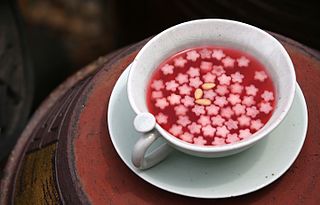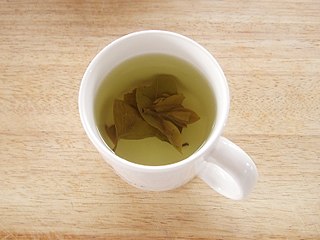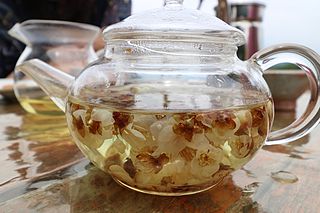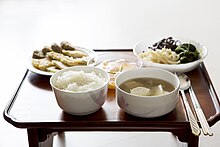
Marmalade generally refers to a fruit preserve made from the juice and peel of citrus fruits boiled with sugar and water. It can be produced from kumquats, lemons, limes, grapefruits, mandarins, sweet oranges, bergamots, and other citrus fruits, or any combination of them, even though the original Portuguese marmalade is produced only from quince.

Yuzu is a citrus fruit and plant in the family Rutaceae. It is called yuja in Korean cuisine. Both Japanese yuzu and Korean yuja are cognates of the Chinese yòuzi (柚子), but the Mandarin word refers to the pomelo. Yuzu is called xiāngchéng (香橙) in Mandarin.

Yuja-cha or yuja tea is a traditional Korean tea made by mixing hot water with yuja-cheong. Yuja tea is popular throughout Korea, especially in the winter. This tea is created by curing yuja into a sweet, thick, pulpy syrup. It is healthy and does not contain caffeine. They are often sold in markets and used in households as a common cold remedy.

Pseudocydonia sinensis, the Chinese quince, is a deciduous or semi-evergreen tree in the family Rosaceae, native to eastern Asia in China, and the sole species in the genus Pseudocydonia. It is closely related to the east Asian genus Chaenomeles, and is sometimes placed in Chaenomeles as C. sinensis, but notable differences are the lack of thorns, and that the flowers are produced singly, not in clusters. The Chinese quince is also closely related to the European Quince, Cydonia oblonga; notable differences include the serrated leaves, and lack of fuzz.

Hwachae is a general term for traditional Korean punches, made with various fruits or edible flower petals. The fruits and flowers are soaked in honied water or honied magnolia berry juice. In modern South Korea, carbonated drinks and/or fruit juices are also commonly added to hwachae. Hwachae is often garnished with pine nuts before it is served.
Yuja-hwachae is a variety of hwachae, Korean traditional fruit punch made with finely shredded yuja, Korean pear, and honey or sugar. In Korea, yuja are largely cultivated in the southern part of the Korean peninsula such as Goheung and Wando, Geoje, and Namhae. Therefore, yuja hwachae has been a local specialty of the Jeolla Province and Gyeongsang Province.

Jeonggwa is a crispy, chewy hangwa with vivid colors and a translucent look. It can be made by boiling sliced fruits, roots, or seeds in honey, mullyeot, or sugar water, then drying the slices, and optionally shaping them into flowers or other decorative forms. The candied fruits, roots, or seeds may have the similar texture to jam, marmalade, or jelly.

Ginger tea is an Asian herbal beverage that is made from ginger root. It has a long history as a traditional herbal medicine in East Asia, Indian subcontinent, Southeast Asia and the Middle East.

Omija-hwachae or magnolia berry punch is a sweet and tangy hwachae (punch) made with magnolia berries—omija in Korean. The reddish-pink punch is typically served during hot summer days.

Mogwa-cha (모과차) or quince tea is a traditional Korean tea made with Chinese quince. Most commonly, mogwa-cha is prepared by mixing hot water with mogwa-cheong. Alternatively, it can also be made by boiling dried quince in water or mixing powdered dried quince with hot water.
Dangyuja is a Korean citrus fruit that is a specialty of Jeju Island. In Jeju language, it is called daengyuji. Dangyuja has a similar shape and flavour to yuja, but is genealogically a variety of pomelo.

Gamnip-cha (감잎차) or persimmon leaf tea is a traditional Korean tea made from the dried leaves of Oriental persimmon.

Maehwa-cha or plum blossom tea is a traditional Korean tea made by infusing dried flowers of Korean plum in hot water. During the early spring, half-open buds of plum blossoms are picked, dried, and preserved in honey. It is served, with ten flowers in a teapot and by pouring 50 millilitres of hot water. The tea can be enjoyed after one to two minutes of steeping.





















